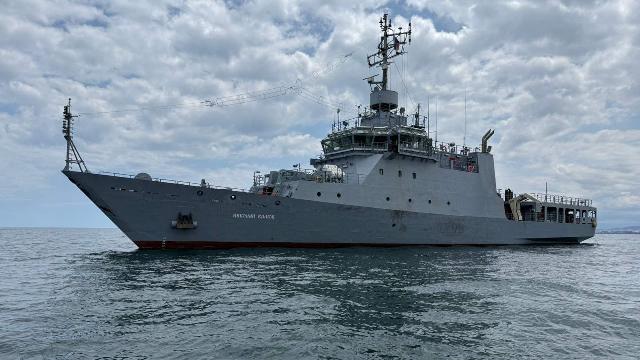Russia's first ship for the training of deck helicopter pilots of the Navy has entered sea trials
The Nikolai Kamov, a training vessel for training naval aviation helicopter pilots, has entered factory sea trials and can be finalized after their completion, a representative of the developer told Izvestia. This project had no analogues either in Soviet times or in modern Russian history. Today, many ships are being built for the Russian Navy, on which helicopters will be based, so a training vessel for pilot training will be in high demand, experts say.
Factory tests of "Nikolay Kamov"
According to the results of the factory sea trials of the Nikolay Kamov training vessel, its improvements can be carried out, a representative of the developer, the Krylov State Scientific Center, told Izvestia.
— The complexity of the technical equipment of such vessels, the huge number of different machines, mechanisms, devices, their compatibility, of course, can cause some things that could not be taken into account when designing, — the specialist explained. — But I'm talking about an option, maybe not the best one. Or maybe everything will go well. After all, there was a preliminary study of individual systems and mechanisms before they were installed on the ship. And now comprehensive tests are being conducted to understand how one interacts with the other.
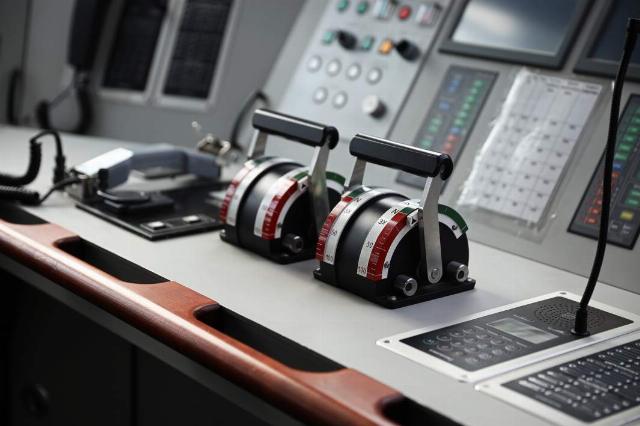
Photo: RIA Novosti/Vitaly Timkiv
Image source: iz.ru
According to him, first of all, the ship's navigational qualities will be checked, as well as how the main engines, steering and anchoring devices, various auxiliary systems and mechanisms work.
— Ship's life support systems, radio engineering and navigation systems, communication systems, rescue equipment, survivability systems and much more are being checked. And already at the final stage, takeoffs and landings on the deck will be practiced," the developer's representative said.
The interlocutor found it difficult to answer the question about the timing of the tests and their completion.
— It is hardly possible to define any clear boundaries, because the vessel is new in its purpose. What will be revealed by the test results? For sure, we will need to finalize something, as well as take into account all the comments and suggestions of the Navy Commander-in—chief that may appear in the process, as it happens when testing any new ship," he explained.
Yevgeny Ivanov, a veteran of naval aviation, told Izvestia that the training vessel should have a number of features.
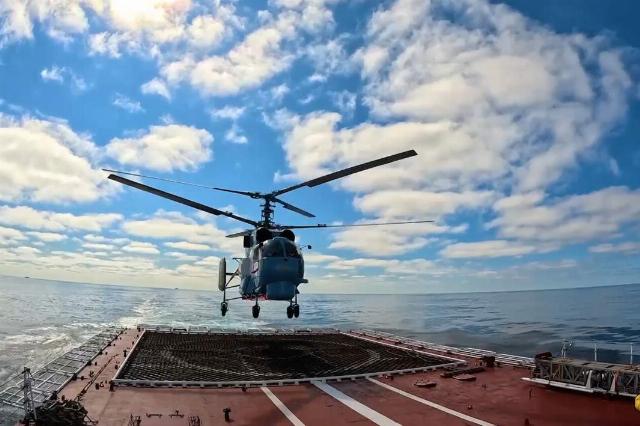
Photo: RIA Novosti/FSB of the Russian Federation
Image Source: iz.ru
— The helipad should be as close as possible to the average site of a warship, corvette or frigate, — he explained. — As a rule, it is 10 by 10 or 12 by 12 m. There must be a hangar. It is important that pilots overcome the psychological barrier. When the ship moves, the hangar creates a shadow, a sparse area is created, and the helicopter is attracted to the hangar. In addition, the ship must be able to create on-board and keeling motion, with an accuracy of degrees.
He noted that thanks to the Nikolai Kamov, the pilots would not have to distract warships for training.
— Recently, ships have been performing many combat missions, and it is very difficult to attract them for helicopter pilots' training. On a training ship, the pilot gets the same skills, supports them, can prepare and take a higher class," concluded Evgeny Ivanov.
Pilot training
"Nikolay Kamov" is designed to practice the elements of take-off and landing of existing and future deck helicopter pilots of the Russian fleet. This is one of the most difficult elements of flight operations, military expert Dmitry Boltenkov told Izvestia.
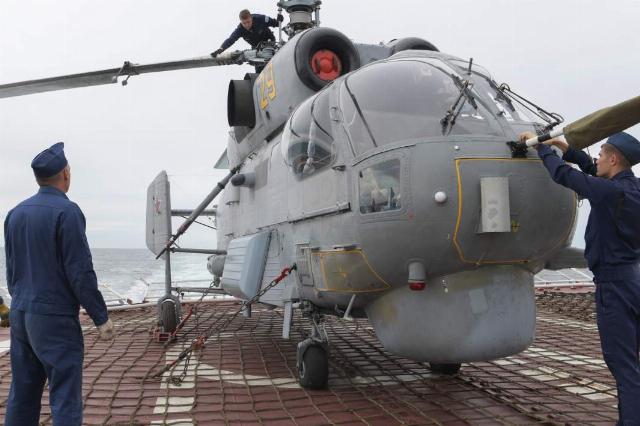
Photo: RIA Novosti/Alexey Nikolsky
Image Source: iz.ru
"A helicopter pilot must be able to take off and land on the deck of a warship swinging in different directions and complete the task assigned to him day and night, as well as in difficult sea conditions," he explained. — So in March 1972, in conditions of an eight-point storm and winds of up to 25 m, the helicopter pilots of the BOD Vice Admiral Drozd removed about 50 submariners from the nuclear submarine K-19 in distress.
Now the need for such a vessel is becoming more urgent in the light of the construction of new warships, in particular, helicopter-based ships, the expert added.
"For example, the amphibious assault ship Project 11711 Vladimir Andreev was recently launched, and the Vasily Trushin and Sergei Kabanov are under construction," he said. — Each of these ships can carry about five helicopters on board. It is known that two universal amphibious assault ships "Ivan Rogov" and "Mitrofan Moskalenko", capable of carrying two dozen helicopters, are being built in Kerch.
According to Dmitry Boltenkov, both Ka-27 family helicopters and Ka-52K combat helicopters can be based on board these ships. This means that in the future, the fleet will need more helicopter pilots than it currently has. Warships of the frigate and corvette classes are also being built, which carry a helicopter on board.
The Nikolay Kamov was laid down on June 28, 2018. It was planned to be completed in 2019, but the deadlines have shifted significantly.
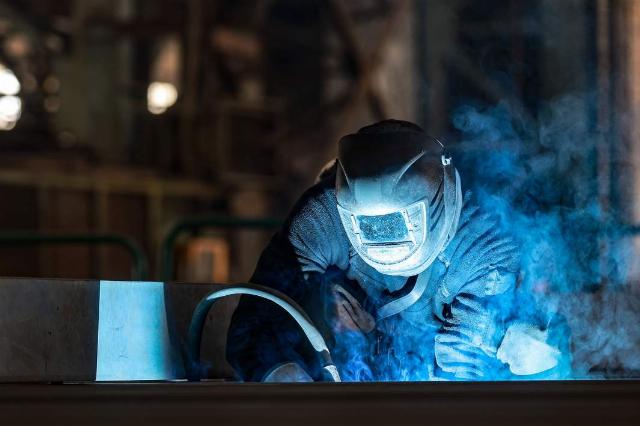
Photo: TASS/Vladimir Smirnov
Image source: iz.ru
— The construction was stopped due to the unavailability of the design documentation and changes in the customer's wishes. In particular, the water cannon was replaced with propellers as a propulsion system, radio navigation equipment and other components were changed. This delayed the slipway period somewhat. In November last year, the vessel was transferred along the Volga River for completion, presumably to Astrakhan. And now the sea trials have begun," Dmitry Boltenkov said.
Izvestia wrote that the Nikolai Kamov was launched on April 24, 2024. Rear Admiral Ilyas Shigapov, head of the Shipbuilding Department of the Main Command of the Russian Navy, said at the time that the ship would be based at the 859th Combat Deployment and Flight Training Center in Yeysk on the Sea of Azov. He noted that his capabilities would be sufficient for high-quality training of naval helicopter pilots and technical personnel. According to the rear admiral, the ship is equipped with a special device so that in calm weather it is possible to simulate the movement of the deck in conditions of rough seas. This way, helicopter pilots will be able to carry out takeoffs and landings as close as possible to the conditions of sea rolling.
The vessel has a displacement of less than 900 tons with a length of about 70 m, a width of more than 12 m and a draft of more than two meters. The full speed is 12 knots, the cruising range is 500 miles with two days of autonomy. The ship is named after aircraft designer Nikolai Kamov, who created marine aircraft, including coaxial helicopters.
The vessel was designed by the Baltsudoproekt Design Bureau (part of the Krylov State Scientific Center).
Roman Kretsul
